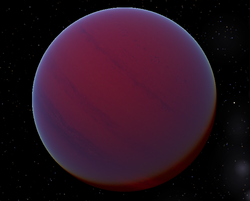HD 29587
(重定向自HD 29587 b)
HD 29587是一颗质量、大小与太阳相似[6]的恒星,可能具有一颗褐矮星伴星[7]。HD 29587位于北英仙座,视星等为7.29[2],不能通过裸眼观测到。根据其每年36.3 mas的恒星视差[1],可以推测出HD 29587距离太阳系约89.8光年。以太阳为参照系,HD 29587正以+113千米/秒的径向速度远离地球[1]。大约148,000年前,HD 29587距离太阳系的距离曾一度近到大约55.8光年[2]。HD 29587属于高速星族[6]。以本地静止标准,HD 29587拥有170千米/秒的相对速度[8]。
| 觀測資料 曆元 J2000 | |
|---|---|
| 星座 | 英仙座 |
| 星官 | |
| 赤經 | 04h 41m 36.31645s[1] |
| 赤緯 | +42° 07′ 06.4209″[1] |
| 視星等(V) | 7.29[2] |
| 特性 | |
| 光谱分类 | G2 V[3] |
| B−V 色指数 | 0.633[3] |
| 天体测定 | |
| 徑向速度 (Rv) | +112.67±0.20[1] km/s |
| 自行 (μ) | 赤经:+534.004[1] mas/yr 赤纬:−414.768[1] mas/yr |
| 视差 (π) | 36.3130 ± 0.0697[1] mas |
| 距离 | 89.8 ± 0.2 ly (27.54 ± 0.05 pc) |
| 绝对星等 (MV) | 5.08[3] |
| 軌道[4] | |
| 繞行週期 (P) | 1,474.9±10.2 d |
| 偏心率 (e) | 0.356±0.095 |
| 近心点 曆元 (T) | 儒略日2,447,763.5±45.8 |
| 近心點幅角 (ω) (secondary) | 80.2±13.3° |
| 半振幅 (K1) (primary) | 1.02±0.16 km/s |
| 詳細資料 [3] | |
| 質量 | 0.78±0.03 M☉ |
| 表面重力 (log g) | 4.54±0.22 |
| 亮度 | 0.798+0.040 −0.038 L☉ |
| 溫度 | 5,709±35 K |
| 金属量 [Fe/H] | −0.51±0.05 dex |
| 年齡 | 14.7+3.8 −2.7 Gyr |
| 其他命名 | |
| 參考資料庫 | |
| SIMBAD | 资料 |
| 系外行星資料庫 | 资料 |
| 系外行星百科 | 资料 |
HD 29587的恒星光谱属于G2 V[3],可划入G型主序星中。她的质量是太阳的78%,恒星光度大约是太阳的80%,表面有效温度是5,709K[3]。
已发现HD 29587的径向速度会发生变化,因而推测可能有一个环绕HD 29587的天体,半长轴(a)与轨道倾角(i)正弦值的乘积(a sin i)是0.0957 ± 0.0108 AU(14.31 ± 1.62 G米)[4]。这一天体HD 29587b质量大约是木星的41.0-97.8倍,因此可能是一颗褐矮星[9]。
| 成員 (依恆星距離) |
质量 | 半長軸 (AU) |
轨道周期 (天) |
離心率 | 傾角 | 半径 |
|---|---|---|---|---|---|---|
| HD 29587 b | ≥0.78±0.03 MJ | ≥0.0957±0.0108 | 1,474.9±10.2 | 0.356±0.095 | — | — |
参考资料 编辑
- ^ 1.0 1.1 1.2 1.3 1.4 1.5 1.6 1.7 Brown, A. G. A.; Vallenari, A.; Prusti, T.; de Bruijne, J. H. J.; et al. Gaia Data Release 2. Summary of the contents and survey properties. Astronomy & Astrophysics. 2018. Bibcode:2018A&A...616A...1G. arXiv:1804.09365 . doi:10.1051/0004-6361/201833051.
- ^ 2.0 2.1 2.2 Anderson, E.; Francis, Ch. XHIP: An extended hipparcos compilation. Astronomy Letters. 2012, 38 (5): 331. Bibcode:2012AstL...38..331A. arXiv:1108.4971 . doi:10.1134/S1063773712050015.
- ^ 3.0 3.1 3.2 3.3 3.4 3.5 Da Silva, Ronaldo; et al. Homogeneous abundance analysis of FGK dwarf, subgiant, and giant stars with and without giant planets. Astronomy & Astrophysics. 2015, 580: A24. Bibcode:2015A&A...580A..24D. doi:10.1051/0004-6361/201525770.
- ^ 4.0 4.1 Halbwachs, J. L.; et al. Exploring the brown dwarf desert with Hipparcos. Astronomy and Astrophysics. March 2000, 355: 581–594. Bibcode:2000A&A...355..581H.
- ^ HD 29587. SIMBAD. 斯特拉斯堡天文資料中心.
- ^ 6.0 6.1 Fossati, L.; et al. The effect of ISM absorption on stellar activity measurements and its relevance for exoplanet studies. Astronomy & Astrophysics. May 2015, 601: 17. Bibcode:2017A&A...601A.104F. arXiv:1702.02883 . doi:10.1051/0004-6361/201630339. A104.
- ^ Mazeh; Latham, David W.; Stefanik, Robert P. Spectroscopic Orbits for Three Binaries with Low-Mass Companions and the Distribution of Secondary Masses near the Substellar Limit. Astrophysical Journal. 1996, 466: 415–427. Bibcode:1996ApJ...466..415M. CiteSeerX 10.1.1.30.5905 . doi:10.1086/177521.
- ^ Hobbs, L. M.; Duncan, Douglas K. The lithium abundance in halo stars. Astrophysical Journal, Part 1. June 15, 1987, 317: 796–809. Bibcode:1987ApJ...317..796H. doi:10.1086/165328.
- ^ 9.0 9.1 Reffert, S.; Quirrenbach, A. Mass constraints on substellar companion candidates from the re-reduced Hipparcos intermediate astrometric data: nine confirmed planets and two confirmed brown dwarfs. Astronomy & Astrophysics. March 2011, 527: 22. Bibcode:2011A&A...527A.140R. arXiv:1101.2227 . doi:10.1051/0004-6361/201015861. A140.
